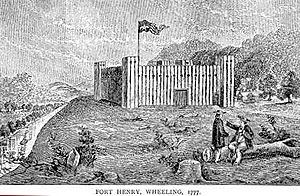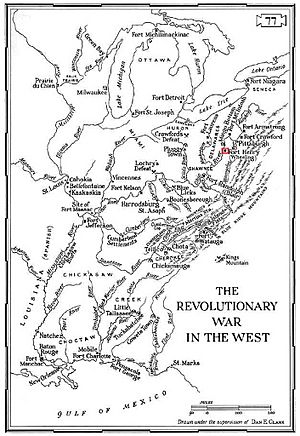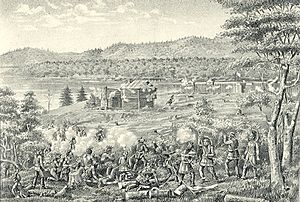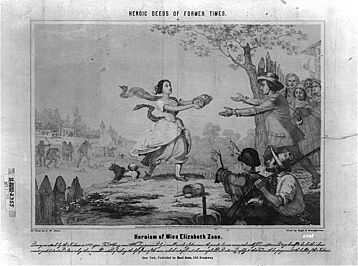Siege of Fort Henry (1782) facts for kids
Quick facts for kids Second siege of Fort Henry |
|||||||
|---|---|---|---|---|---|---|---|
| Part of the American Revolutionary War | |||||||
 Sketch of Ft Henry |
|||||||
|
|||||||
| Belligerents | |||||||
|
Wyandot Shawnee Seneca and Delaware Indians |
||||||
| Commanders and leaders | |||||||
| Colonel David Shepard Colonel Silas Zane |
Captain Pratt Simon Girty |
||||||
| Strength | |||||||
| Just over 40 Virginia militia | 50 British officers and Loyalists ("Butler's Rangers") 260 Native Americans |
||||||
| Casualties and losses | |||||||
| 1 wounded | Unknown | ||||||
The second siege of Fort Henry happened from September 11 to 13, 1782. It was a key event during the American Revolutionary War. A large group of about 300 Native American warriors from the Wyandot, Shawnee, Seneca, and Delaware tribes attacked Fort Henry. This fort was an American outpost in what is now Wheeling, West Virginia. They were joined by 50 British officers and Loyalists from a group called Butler's Rangers.
This siege is often called "The Last Battle of the Revolutionary War." While some smaller fights happened later, this was the last major planned attack. It showed the end of large-scale fighting in the war.
Contents
Where Was Fort Henry?
Fort Henry was located near the Ohio River in what is now Wheeling, West Virginia. This area was between the borders of Ohio and West Virginia. At the time, colonists were moving into lands west of the Appalachian Mountains. This went against a royal rule that these lands were for Native Americans. Because of this, there was often fighting between settlers and Native Americans in the area.
The Attack on Fort Henry
A large force of Native Americans gathered by the Sandusky River. They were led by Simon Girty. Girty had been captured by Native Americans as a child and grew up among them. He was known for his harsh actions against settlers. This force then met up with Butler's Rangers. The whole group was put under the command of Captain Pratt. Butler's Rangers were a Loyalist unit from New York.
When the attackers arrived at Fort Henry, the Zane family and Colonel David Shephard were in charge of defending it. The fort's defenders included about 40 men and boys. They were protecting 60 women and children who had come to the fort for safety.
Girty and Pratt demanded that the fort surrender. But Colonel Shephard refused. He decided they would fight to protect everyone inside. The settlers were ready for this attack. A similar force of Native Americans and British had attacked the fort before in 1777. That time, they burned all the homes outside the fort.
Between the two attacks, the fort had improved its defenses. A real cannon replaced an old wooden one. Settlers' homes, including Ebenezer Zane's, were rebuilt. His home had extra ammunition and weapons. They decided to use it if another attack happened. A scout named John Lynn warned them the enemy was coming. This gave them time to prepare quickly.
Some people stayed in the Zane house. These included Andrew Scott, George Green, Elizabeth Zane (Colonel Zane's wife), Molly Scott, Miss McCulloch, and two enslaved people, "Daddy Sam" and Kate. Everyone else from the surrounding homes went into the fort. Colonel Silas Zane was in charge of the fort's defense.
The first attacks aimed to destroy the fort and the area around it. The first day was spent trying to break down the fort walls and burn buildings. On the first night, Native Americans tried to burn Colonel Zane's cabin. But Daddy Sam saw them and stopped the fire. The fort's cannon was used many times. It was so effective that the attackers tried to make their own cannon. They hollowed out a tree and wrapped it in chains. But when they tried to fire it, it exploded. This killed and injured some of the attackers. While the men fought, the women inside the fort made bullets. They poured lead into molds and cooled them in water.
On the second day of the siege, the settlers faced a big problem. Their gunpowder supply was running low. They would not be able to keep fighting much longer. Elizabeth "Betty" Zane remembered that her brother's cabin had a store of powder. She bravely offered to get it. She had three good reasons:
- The enemy might be less likely to shoot a woman.
- The fort had only 20 fighting men left, and they couldn't spare any.
- She knew exactly where the powder was kept in the cabin.
- She was young and strong enough to carry the powder back.
Betty Zane had also been working for 40 hours without sleep. She had been molding bullets for the soldiers.
Around noon on the second day, Betty Zane opened the fort's front gate. She walked about 60 yards to Ebenezer Zane's cabin. The fighting stopped as the attackers watched her. They were amazed as she went into the cabin. Betty was not as lucky on her way back. She wrapped the powder in her apron and left the cabin. When the attackers saw what she had, they started shooting at her. She ran the 60 yards back up the hill to the fort. She made it safely inside, unharmed. The new powder allowed the settlers to keep defending the fort.
The next morning, the Native American and British forces left. Patriot Captain John Boggs arrived with 70 soldiers to help Fort Henry. The fort had survived!
What Fort Henry Looked Like
The fort was built in 1774 and named after Patrick Henry. It was shaped like a parallelogram, about 356 feet long and 150 feet wide. This was about three-quarters of an acre. It sat on a hillside, with Wheeling Creek on its south side.
The fort had a twelve-foot wall around it. There was a wooden tower at each corner. Each tower had small openings for muskets and rifles. Strong oak and hickory pickets connected the towers. Most of the fighting during attacks happened from these towers. Inside the fort were cabins and barracks. These sheltered people from the surrounding area. On top of the barracks was a swivel cannon. This cannon was very important for the fort's survival.
Fort Henry had one main entrance with a heavy wooden gate. It also had a smaller, strong side entrance. There was a well inside the fort, fed by a fresh spring just outside the walls. Fort Henry was thought to be very strong. People believed it could not be captured as long as its defenders had supplies. The area around the fort was cleared and fenced for about one-eighth of a mile. This made it even easier to defend against attackers.
People Who Defended Fort Henry
Many Americans defended Fort Henry during the attack. Not all names were written down, but here are 47 people who helped defend the fort from September 11–13, 1782:
- Lydia Boggs
- Andrew Scott
- James Boggs
- Molly Scott
- Agnus/Shamus Bruce
- Robert Scott
- Margaret Bruce
- Henry Smith
- James Caldwell
- James Smith
- Harry Clark
- Thomas Smith
- James Clark
- Conrad Stroop
- Casper French
- Copeland Sullivan
- George Greer
- Rachael Sullivan
- Rachael Johnson
- Copeland Sullivan (Jr)
- George Kerr
- John Tait
- Hamilton Kerr
- Samuel Tomlinson
- Morton Kerr
- Conrad Wheat
- John Mcculloch
- Betsy Wheat
- Alexander McDowell
- George Wright
- Sarah McDowell
- Andrew Zane
- Alkenna McIntyre
- Ebenezer Zane
- Johnathan McIntyre
- Elizabeth Mcculloch-Zane
- Edward Mills
- Elizabeth "Betty" Zane
- Thomas Mills
- Jonathan Zane
- Old Mrs. Mills
- Silas Zane
- Peter Nisewanger
- Old Daddy Sam
- George Reikart
- Kate (Sam's Wife)
- Jacob Reikart
- Nicholas Rodgers
- Abraham Rodgers (son of Nicholas)





